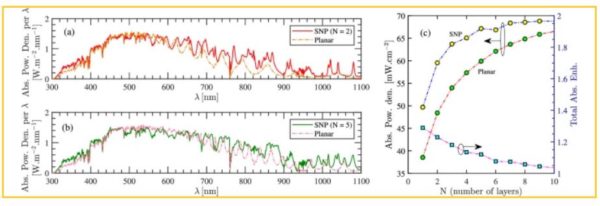Scientists in Iran have proposed the use of multi-layer silicon dioxide (SiO2) nanoparticles as p–n junctions in ultra-thin solar cells to enhance their photocurrent. The researchers demonstrated a multi-layer silicon nanoparticle (SNP) solar cell based on nanoparticles that are densely stacked inside a dielectric medium.
“We show how this inherently textured architecture acts as a light absorber while having the potential to separate and transport photo-generated carriers,” they said. “We also assume a metallic contact (silver) below, and an anti-reflection coating (ARC) above the absorbers to further resemble a real cell.”
They assumed that the nanoparticles were spherical with a selected radius of 300 nanometers and a refractive index of 1.8, which is in line with values provided by materials such as PEDOT:PSS and spiro-OMeTAD. They compared the absorption spectra of a multi-layer SNP absorber with two and five layers of silicon nanospheres to that of a flat layer and found that these particle-based structures provide improved absorption, at longer wavelengths.
“Increasing the number of SNP layers reduces the advantage of the SNP structure in comparison to a planar one,” they said. “This indicates that the SNP cell is optically preferable only when a few layers are used.”

Image: University of Tehran, scientific reports, Creative Commons License CC BY 4.0
The research group also found that a dense distribution of SNPs is preferable to sparse ones for solar cell applications.
“This is because SNPs are assumed to be the main absorber in the cell. Thus, any distance between them reduces the absorption of incident photons,” the group said.
They considered different SNP structures and configurations to tailor these particles as a p–n junction cell. They said this kind of cell could achieve a theoretical efficiency of around 11%.
“Moreover, we showed that by including silica nanoparticles of proper size on top of the cell structure, one can enhance the photocurrent up to around 10%,” they said.
Popular content
They described the novel cell concept in “Design and analysis of multi-layer silicon nanoparticle solar cells,” which was recently published in Scientific Reports.
“The cell configurations introduced in this study provide improved optical absorption in an inherently textured structure,” they said. “Interestingly, these features even happen for configurations with random distributions of nanoparticles; this issue leads to a simplified way for fabrication of these ultra-thin cells.”
Another recent study at Penn State University shows that nanoparticles boost solar cell efficiency, but not for the reason the researchers expected.
“But this research shows that it doesn’t matter if you put in up-conversion nanoparticles or any other nanoparticles – they will show the boosted efficiency because of the enhance light scattering,” they explained.
They said that by simply changing the shape, size and distribution of nanoparticles within the solar cells, higher efficiencies could be achieved.
“So some optimum shape, distribution or size can actually lead to even more photocurrent enchantment,” the Penn State team said. “That could be the future research direction based on ideas from this research.”
This content is protected by copyright and may not be reused. If you want to cooperate with us and would like to reuse some of our content, please contact: editors@pv-magazine.com.



1 comment
By submitting this form you agree to pv magazine using your data for the purposes of publishing your comment.
Your personal data will only be disclosed or otherwise transmitted to third parties for the purposes of spam filtering or if this is necessary for technical maintenance of the website. Any other transfer to third parties will not take place unless this is justified on the basis of applicable data protection regulations or if pv magazine is legally obliged to do so.
You may revoke this consent at any time with effect for the future, in which case your personal data will be deleted immediately. Otherwise, your data will be deleted if pv magazine has processed your request or the purpose of data storage is fulfilled.
Further information on data privacy can be found in our Data Protection Policy.